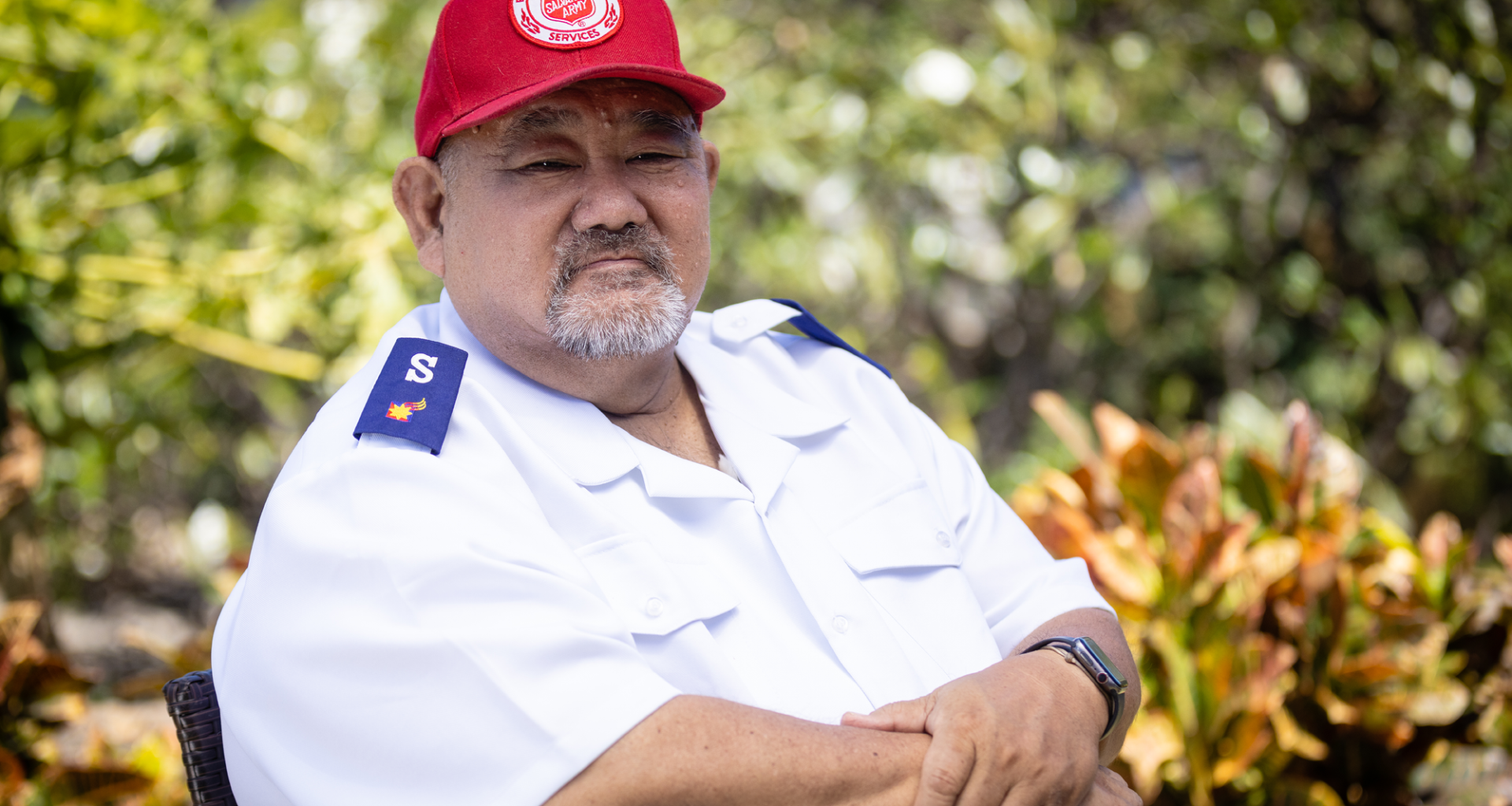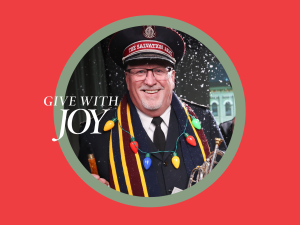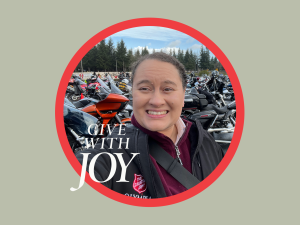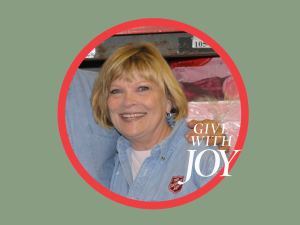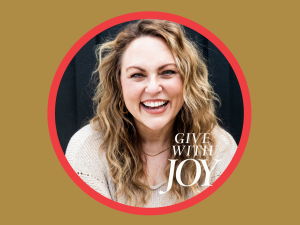We’ve said it before: The Salvation Army’s disaster relief operation never sleeps. Perhaps that could not be more true than in the case of Envoy Kevin Nagasaki who is in-charge of the Lahaina Lighthouse Corps in Maui, Hawaii.
You’ll remember last August, the Lahaina Lighthouse Corps burned along with historic Lahaina town in the deadliest U.S. wildfire in more than a century. For Envoy Nagasaki, this disaster was personal: The corps complex contained spaces for worship, social services and a thrift store, along with the home he shared with his wife as ministry leaders in the community for nearly 30 years.
So not only was the community he loves leveled, and he himself directly impacted by the fires, he was on the frontlines of service responding to them too. Less than 24 hours after the fires, he was delivering food across shelter sites and serving first responders as part of The Salvation Army’s coordinated effort on the island of Maui that is still ongoing.
The Salvation Army orchestrated the delivery of more than 800,000 meals and made an additional 120,000 meals when it served as the primary feeding organization in the immediate aftermath of the fires. That’s in addition to thousands of encounters of emotional/spiritual care and about $1 million in gift card assistance to help survivors in their journey to transition out of hotels and into longer-term housing situations.
In this episode, guest hosted by Managing Editor Hillary Jackson, Envoy Kevin Nagasaki shares a glimpse of what it’s like to respond to a disaster when you’re truly in it yourself. He shares the hope he has for his community, and how it’s finding renewal.
Show highlights include:
- Envoy Kevin Nagasaki remembers the day fire spread through Lahaina, Maui.
- What it was like to serve as the primary feeding organization for the immediate relief phase of the emergency/disaster response while experiencing the disaster yourself.
- The conversations he is having with people who are in recovery from the fire.
- What the Lahaina Lighthouse Corps was like before it burned.
- How his ministry has changed.
- How he has witnessed healing, and what’s next.
Listen and subscribe to the Do Gooders Podcast now. Below is a transcript of the episode, edited for readability. For more information on the people and ideas in the episode, see the links at the bottom of this post.
* * *
Take me back to the day of the fires…Where were you when they started?
Was a typical Tuesday morning, August 8. We went to the food bank at five o’clock in the morning. And we came back, just about 7:30. And then they said there was a fire up Lahaina Luna, and so we unloaded the van and we did some things to get ready for lunch. And then we took a drive up there.
By the time we went up there, about one o’clock, the fire was already done; it was out. And so we came back down. But we had no power. So you know, we just kind of hung out. Then at just about three o’clock, I want to say two-something, then they said another fire had started. So I said, ‘Oh, you know, I guess, you know, they’ll put it out just like the last one.’ But then, you know, as it got later on in the day, like, four or five o’clock—hours later—they said, ‘Oh, the fire is moving down the hill.’
And it was gusty. I mean, it was 70-80-90 miles-an-hour wind coming down. I mean, it blew our tent; it blew everything. I mean, there are leaves, there are trees down there, you know, power lines down on the road. And then all of a sudden, it hit the town.
And then that’s when the major part of the fire started. And, you know, they said, ‘Oh, the fire is coming my way.’ And I said, ‘Oh, it was two streets down.’ Within 15-20 minutes, it was one street away from us. And I tried to fight it with a garden hose. But it was unsuccessful, so we got everybody, the corps members and whatever people that was around—homeless, and we said, ‘Just jump in the truck. Let’s go already.’
I mean, the corps building and the quarters were already on fire. So we went up the hill to the safe zone, and we waited and we seen the, you know, other churches and other things being burned. And, you know, we said, ‘It’s pretty much gone.’ Then it got kind of close to us because we were by the shelter. So we said, you know, ‘Let’s just pack up and let’s go.’ So we went on to the top of the bypass, and looked down onto this, onto the town, and it was just a big cloud of dark smoke. And then we said, ‘Oh, well, well, we’ll just head to the other side.’ And so I called the Captain Steve Howard, and we said, you know, ‘The corps is gone.’
Once you made it to the Kahului side, then what happened?
I didn’t sleep that night, because I really was thinking: ‘What’s the next move here? What is the next thing we’re gonna have to do?’ And it was: We’re gonna have to feed the people. We don’t know where they are. They opened the gyms, and you know, we can’t get to this side, the road is closed. And so we said, ‘OK, well, you know, we need to make some meals for them.’ So we started making meals that very next morning, and we took them out to the different gyms that were open.
We started off with, you know, three sites, then went to, you know, six sites, went to 10 sites and was just, was just overwhelming, you know? We was making over 1,000 meals for each one, you know, and then we moved on, and we got help from DHQ. THQ started coming, and then everything started to move forward. And then we crossed the void. That’s what The Salvation Army does: We bring the spiritual part and the meal part.
The Salvation Army served as the primary feeding organization for the immediate relief phase of the emergency/disaster response, coordinating more than 800,000 meals and making some 120,000 of them. What was it like for you to go from losing everything into serving others within 24 hours?
I guess that’s the nature of the course. I mean, it’s not the first time, you know, but this is the first time that it was that day. I mean, we had other fires before. We just put the stuff in a box truck. We cooked everything in a box truck. We fed the firemen. We fed everybody out of our box truck. Road closed, we would bring coolers of water. We’d pass waters in the lines of cars. We didn’t, you know, it wasn’t like our first rodeo. But being this big, definitely, you know.
But, you know, having the people, having the backing of the community, and everything else, made it more stronger. And going to the different sites that were open, it made a difference because people were seeing me, and I see the other people, and they knew that we were alive, that we survived. And, you know, it was good to see a lot of different people. And a lot of seniors that were there, you know, it was good that they got out. A lot of people lost their lives. But you know, we made it through. You know, 101. And, basically, we knew all of them.
In the immediate aftermath of the fires, some 8,000 Lahaina residents were living in hotels—and you were among them… What was that like?
Chaos. I’m just kidding. I mean, I had a roof over my head. I’m thankful. Thank you, Jesus, for having a roof over my head, and a place to sleep and a place to shower. But I do understand what other people went through that, you know, you have to: ‘OK, today, you stayed at this hotel. OK, this week, you’re gonna have to pack up your stuff, and we’re moving you to another hotel in another part of the island. Oh, and by the way, in two weeks, we’re going to move you again to another place. Oh, by the way, you have 72 always to move, but no, I’m going to move you in 12.’
It was, it was difficult. But like I said, for me, I don’t mind moving, as long as you tell me. And I think that’s the same thing that the people who were there was wanting, too, you know. If you give them enough notice, they can understand, ‘OK, we’re moving. We’re not getting kicked out. We’re not being displaced,’ you know, and we are survivors. So we’re going to move forward.
Did you connect with people in the hotel while you were living there?
Yes, moving them, talking to them. You know, a lot of them were employees of the hotel that were staying there, so, you know, we had a chance to speak to them, you know, and they were sad and you know, that, you know, they don’t have no place. And it’s hard living and working at the same place you live and you work is a tough one.
So much of your work as an envoy is about relationships, and building those with people… What are the kinds of conversations you’re having with people who are in recovery from the fire?
They always ask ‘how are you doing?’ You know, I try not to ask that question anymore. Because, I mean, I already know how they’re doing. But I mean, not not in a funny sense, but in a sense, I try to lighten, you know: Have you seen this person? Or: Have you spoken to her? You know, try to lighten the mood a little bit. It’s, you know, to get them out of that, you know, to speak about what’s really, really going on inside of them. So it helps to break the ice that way instead, you know.
Because I just found out that, you know, even me being asked that question 1,000 or maybe more times, it kind of gets monotonous. So I’d rather open up with another question. And it helps them to, you know, to open up, and, you know, talk about what’s going on, how are they feeling, in a different way. And a lot of people have learned that they’re, you know, that they’re not alone. And they’re just trying to get back to where they were. And of course, they’ll never be the same. And we understand that there is never going to be the same Lahaina town. But we can at least put our input on how it should be, and how the things you change.
Before the fires, can you tell me a little bit about what the corps was like?
The people that used to come there, were most, 98 percent were homeless. Our chapel would be maybe anywhere from, you know, 30 to 40 homeless people, who used to come on Sundays. Wednesdays, we had a praise and worship, and movie night on Fridays. And we had ‘Fishers of Men,’ we’d take all the men fishing. We do a lot of things there. And we had a drop-in center where people could come, take a shower or wash their clothes—do all kinds of things that they needed to do to further and better their lives.
You’re an envoy without a corps building. How has that changed your ministry?
Not by much. I mean, it’s just not a having a physical building. But still having the people and going out there in the community, you know, speaking to the hotel managers, speaking to the county speaking to a lot of the people, not just the homeless community. But you know, I mean, having still having that community connection, keeping it strong, so that, you know, when we do set up and get ready to open up again, we have that stability.
It’s a long road ahead…How have you witnessed healing?
I have seen some moving forward. Yes. And then, you know, of course, you know, everybody grieves different. Some people take longer, some people get over it quickly. Some people maybe will never get over the, you know, the loss of, you know, all their belongings or family members or whatever. You know, I think it’s just gonna take time, you know, knowing that this community is strong. You know, that’s why they use that term, ‘Lahaina Strong.’ I think as far as this is not the first fire that happened. There was a fire earlier, in the early 1900s that burned down the whole Lahaina Town too, so this is the second. But not as many people died in that fire. You know, but I think that in time, the healing will happen. But it’s just going to take time, and everybody processes differently.
What’s next for the Lahaina Lighthouse Corps?
My mantra is being ‘build bigger and better.’ But, you know, we’re gonna have to see, you know, there’s a lot of unknowns yet as far as where is it going to be, how big the building is going to be, what we can do, what we cannot do. It’s going to be a change; it’s going to be different, definitely different. But you know, the spirit and, and, and the mission of Salvation Army, I think, is still going to be out there to meet the need, no matter what.
What difference do you hope to make?
If I can keep connecting with the people, you know, that’s part of our mission here. It doesn’t matter if you live on the hill, or you live on the beach, you know, Salvation Army is here to help you. Salvation Army is, you know, here in the community, to keep it going, you know, to keep that connection. Social service, family service, thrift store, Christmas time, bell ringing, Angel Tree, whatever it’s going to take, you know, keep that ministry going. That’s what we need to do here. And that’s my mission.
Additional resources:
- See how The Salvation Army fights disaster.
- Get on the list for Good Words from the Good Word and get a boost of inspiration in 1 minute a day with a daily affirmation from Scripture sent straight to your inbox. It’s an email to help you start your day with goodness.
Listen and subscribe to the Do Gooders Podcast now.








